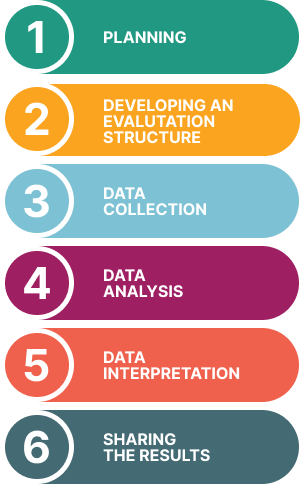Considerations to Guide Quality Evaluations is an infographic for everyone involved in evaluation. The CES Alberta & NWT Advocacy Committee developed it through a systematic and rigorous process. It is a succinct and easy-to-understand overview of the types of questions to consider at each stage of an evaluation.
The infographic was developed for people who:
- Commission evaluation
- Use evaluation results
- Conduct evaluations
Why?
- Help people know what should be considered at the different steps of an evaluation.
- Enable people to know what to expect during a quality evaluation process, so they feel confident asking questions.
- Show that the practice and process of a quality evaluation has a coherent, systematic structure.
- Demonstrate the competencies that underlie professional evaluation practice as defined by the CES Credentialed Evaluator (CE designation).
Ideas for using the Considerations to Guide Quality Evaluations infographic
- Help guide discussions about what should be discussed and the decisions to be made at each step of the evaluation.
- Use as a checklist with clients during the evaluation to double check what has – or hasn’t – been asked.
- Introduce evaluation to clients and explain why certain things need to happen at certain points in time.
- Introduce students to evaluation in courses and workshops
- Explain evaluation to people unfamiliar with professional evaluation practice.
- Inform Requests for Proposals and Terms of Reference for evaluations
- And many other yet-to-be discovered opportunities!
Considerations to Guide Quality Evaluations
Considerations to Guide Quality Evaluations is an infographic for everyone involved in evaluation. The CES Alberta & NWT Advocacy Committee developed it through a systematic and rigorous process.
It is a succinct and easy-to-understand overview of the types of questions to consider at each stage of an evaluation.
The infographic was developed for people who:
- Commission evaluation
- Use evaluation results
- Conduct evaluations
Why?
- Help people know what should be considered at the different steps of an evaluation.
- Enable people to know what to expect during a quality evaluation process, so they feel confident asking questions.
- Show that the practice and process of a quality evaluation has a coherent, systematic structure.
- Demonstrate the competencies that underlie professional evaluation practice as defined by the CES Credentialed Evaluator (CE designation).
Ideas for using the Considerations to Guide Quality Evaluations infographic
- Help guide discussions about what should be discussed and the decisions to be made at each step of the evaluation.
- Use as a checklist with clients during the evaluation to double check what has – or hasn’t – been asked.
- Introduce evaluation to clients and explain why certain things need to happen at certain points in time.
- Introduce students to evaluation in courses and workshops
- Explain evaluation to people unfamiliar with professional evaluation practice.
- Inform Requests for Proposals and Terms of Reference for evaluations
- And many other yet-to-be discovered opportunities!









